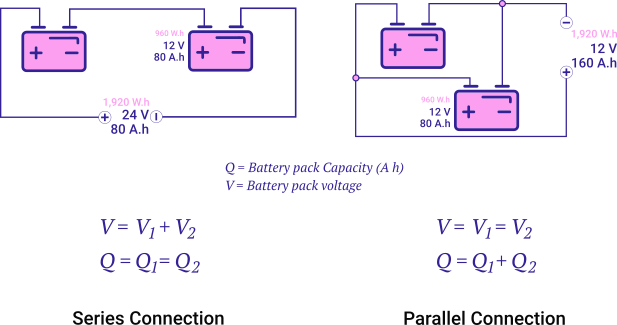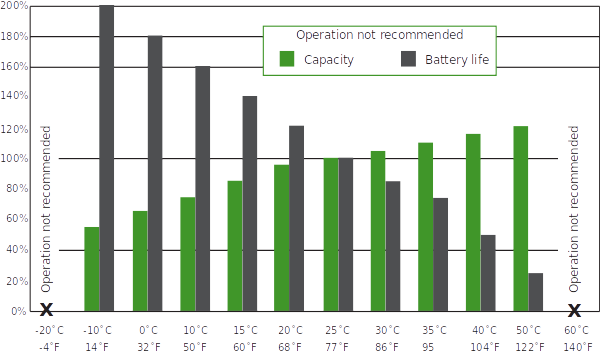RV/Boat PV system: How to size your battery bank?
Disclosure: Some of the links in this post are affiliate links.This means if you click on the link and purchase the item or sign up for services I trust and recommend, then I will receive a commission at no extra cost to you. Thanks.
The next step after deciding your solar power need is to size your PV system battery bank. It is a very important component of PV systems. Batteries are energy storage units that help us deal with the irregular nature of power generating of PV systems. They provide energy at night and during periods of limited sunlight.
First, in this article, we will take a look at some basic characteristic parameters of solar batteries (rechargeable batteries used in PV systems) that we need to know for our purpose. Next, I will show you how to calculate your battery pack (set of identical battery modules) size (A.h) and its proper configuration.
Nominal Voltage (V)
This is the voltage reference at which the battery is supposed to operate. In an RV/Boat PV system, the rated battery voltage is usually 12 V or 24 V. Practically, the actual voltage of PV system could be different from the nominal voltage, depending on the instant load conditions, state of charge (SoC) and temperature of the batteries.
Battery Capacity
It is the total amount of charge (coulomb, C) available from the battery at the rated voltage. The battery capacity is measured in ampere-hours (A.h), which is also used as an alternative unit of measurement for electric charge.
For example, if a battery’s capacity is 100 A.h, it indicates that the battery could be fully charged/discharged in 100 hours with a constant 1 A current.
Depth of Discharge (DoD)
It refers to the percentage of the battery’s capacity that has been discharged over the rated capacity. The maximum allowable DoD is used for sizing the battery bank. This limitation is necessary to increase the life of the battery and depends on battery type.
For example, if we discharge a 100 A.h battery for 80 hours with a constant 1 A current, the DoD will be 80%.
Days of Autonomy
In an off-grid PV system, designers consider the reserved energy capacity stored in batteries for safe operation during periods of limited sunlight. This reserved energy will provide some days of autonomy from PV panels energy generation. For off-grid home PV systems, it could be up to 5 days, depending on the geo-location.
It is not the case for an RV/Boat PV system. Because there are other energy resources available on your vehicle that could charge the batteries and will make the additional battery storage pointless and economically inconvenient. However, it is your system and you have to design it based on your needs. Here I just wanted to show you how to consider it in the calculations if you wish to. We could put this factor equal to 1 to prevent oversizing the battery pack.
Battery bank Capacity and Configuration
In the previous article, through steps 2 to 5, we decided our system nominal voltage and learned how to find our PV system total energy requirement in amp-hours. Now we can proceed with our calculation and determine our PV system battery bank capacity.
Like PV panels, batteries can be connected in series (forming a string) or parallel (forming a block). In a series connection, the overall voltage will increase as the sum of the voltage of each battery in the string increases, but the capacity will remain the same as a single battery. While in a parallel connection, the total capacity will be the sum of the capacity of each battery and the voltage will not change.

The total number of batteries you will need depends on your selected battery characteristics. To find the required battery capacity of our PV system, we need to know the recommended depth of discharge (DoD) of our battery and use the formula below:
![]()
To give you a numerical example, we continue with 127.37 A.h energy requirement (step 5) and 12 V nominal system voltage. Also, I consider a 12 V, 80 A.h battery with 80% DoD and a day of autonomy for my system. (In your calculations, round up to the highest whole number)
(127.37 × 1) ÷ 0.8 = 159.21 A.h round up to 160 A.h
The number of required batteries in parallel:
![]()
Nbat, p = 160 ÷ 80 = 2
The number of required batteries in series:
![]()
Nbat, s = 12 ÷ 12 = 1
And the total number of batteries will be:
![]()
Nbat = 2 × 1 = 2
As you can see in this example, I will need two of this type of battery connected in parallel. You should be aware that having multiple batteries connected in series/parallel could damage battery pack performance. The mismatching effects in series connection could lead to system failure and if you connect an old battery with new ones in parallel, it will accelerate their ageing. The good choice is to select a higher capacity battery with proper voltage to reduce the number of series and parallel connections.
Conclusion
Batteries are the part of the system that will most likely experience problems, so you have to select carefully. A good battery will cost more but it will pay off over the years. Find the cost per cycle-life of different batteries and compare their characteristics, then choose the one that best meets your PV system requirements.
Lastly, I want to point out the temperature effects on batteries. All batteries have a specific range of operating temperatures, depending on their types (AGM, lithium-ion, etc.), but their overall behavior is the same.

Representative chart of temperature effects on battery capacity and life [src]
A high temperature will increase the battery capacity (A.h) but on the other hand, will decrease the battery life-time. The optimal operating condition is at room temperature around 25 C (77 F). Knowing this, you should place your battery pack inside your RV/Boat cabin, where it will perform best and will last longer.
References
[1] Xiao, Weidong. Photovoltaic Power System : Modelling, Design and Control, John Wiley & Sons, Incorporated, 2017.
[2] Smets, Arno & Jäger, Klaus & Isabella, Olindo & Van Swaaij, R.A.C.M.M. & Zeman, Miro. (2016). Solar Energy – The physics and engineering of photovoltaic conversion, technologies and systems.
[3] Mohanty, Parimita & Karnamadakala, Rahul Sharma & Gujar, Mukesh & Kolhe, Mohan & Azmi, Aimie. (2015). PV System Design for Off-Grid Applications. 10.1007/978-3-319-14663-8_3.
[4] Shuai Ma, Modi Jiang, Peng Tao, Chengyi Song, Jianbo Wu, Jun Wang, Tao Deng, WenShang. (2018) Temperature effect and thermal impact in lithium-ion batteries: A review.
[5] Lead Acid Batteries – Battery Lifetime.
[6] Series and Parallel Battery Configurations.
